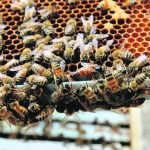Higher-than-normal loads of mites that have built up resistance to pesticides have helped lead to higher-than-normal rates of winterkill in Alberta bees, according to the provincial apiculturist.
Alberta producers are seeing about 25 per cent overwintering losses, the province said, compared to the normal 15-20 per cent range.
“The hardest hit regions are the Peace region and the northwest region which includes Barrhead and Westlock,” said Paul Laflamme, head of the pest management branch with Alberta Agriculture and Rural Development in Edmonton, in a provincial ag newsletter.
Read Also

Mexico agriculture secretary says still no date for restarting cattle exports to U.S.
Mexican Agriculture Minister Julio Berdegue said on Wednesday that Mexico and the United States have not yet set a date to resume Mexican cattle exports amid an outbreak of the flesh-eating screwworm parasite.
The provincial apiculturist reported the main causes to be high mite loads and “failure of miticides to control these pests,” Laflamme said.
Mites, he said, are developing a resistance to the two miticides registered for use in Canada.
Although apiculturists and the Canadian Honey Council are pressing Health Canada’s Pest Management Regulatory Agency (PMRA) for an emergency-use registration for a new product,”the final decision for registration is PMRA’s, and depending on the pesticide, this can take some time.”
Alberta’s overwintering losses are not due to colony collapse disorder (CCD), blamed for losses among some U.S. beekeepers of between 30 and 90 per cent starting in the fall of 2006. CCD and the symptoms that are described under that title in the U.S. have not been reported in Canada, the province said.
So far, any reports of CCD-like symptoms investigated by AARD’s apiculturist have been due to other causes, the province said.











